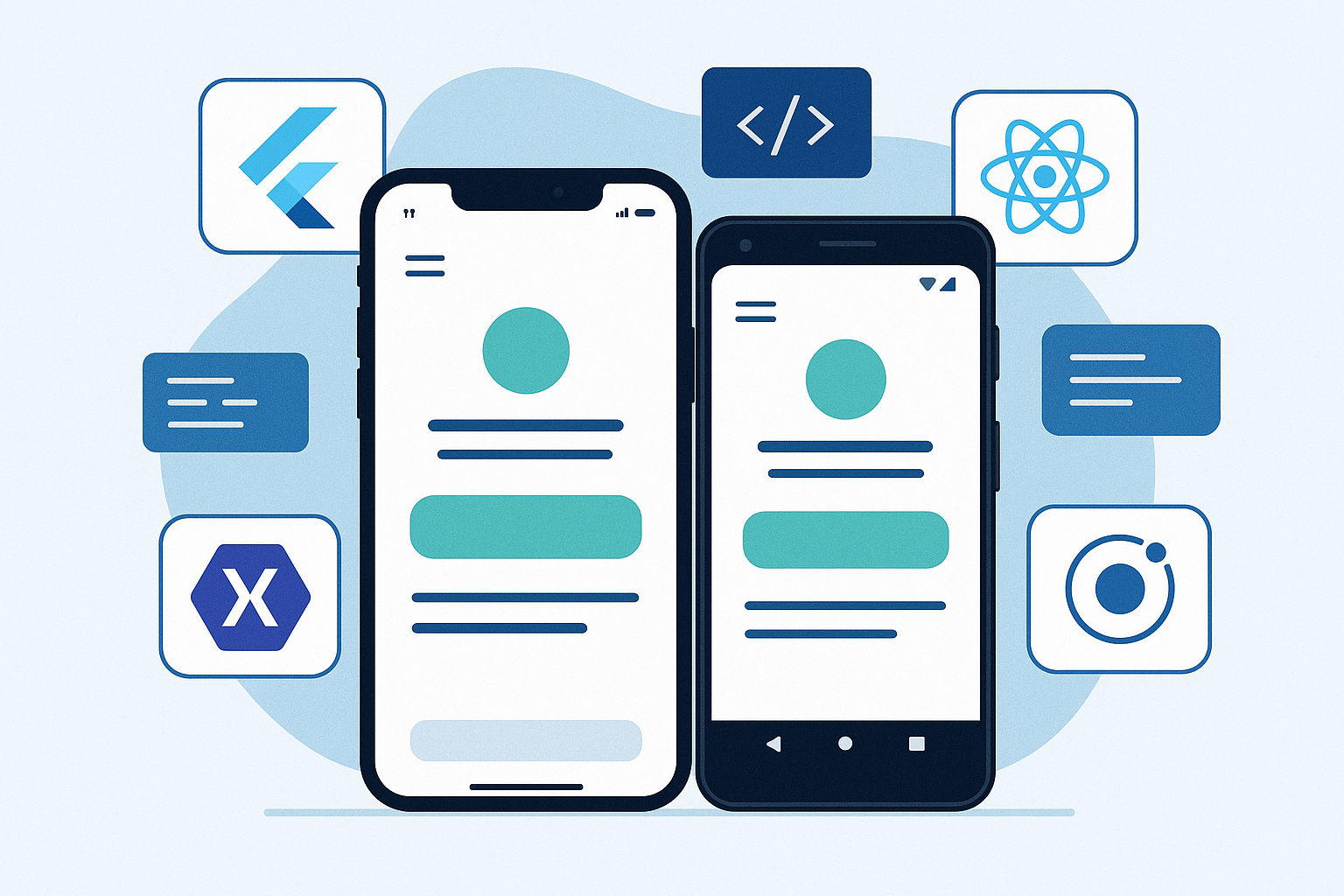Mobile Development Frameworks: The Complete Guide for Building Apps in 2025
Compare top mobile development frameworks like Flutter, React Native & Xamarin. Learn which cross-platform framework fits your 2025 app project best.

The mobile development frameworks landscape has transformed dramatically, and picking the right one can make or break your app project. With over 6.8 billion smartphone users worldwide, businesses need apps that work seamlessly across platforms without breaking the bank or taking forever to build.
Whether you’re a startup with a tight budget or an enterprise planning your next digital transformation, understanding cross-platform mobile app development frameworks is crucial. The choices you make today about Flutter, React Native, or native development will impact your app’s performance, development speed, and long-term success.
This guide cuts through the marketing noise and gives you practical insights about the top mobile app frameworks 2025 has to offer. We’ll explore what works, what doesn’t, and help you choose the framework that actually fits your project needs. From Google’s Flutter to Meta’s React Native, and everything in between, you’ll understand the real trade-offs each option presents.
Understanding Mobile Development Framework Types
Native Development Frameworks
Native app development means building separate apps for each platform using platform-specific languages and tools. For iOS, you’ll use Swift or Objective-C with Xcode. For Android, you’ll work with Kotlin or Java using Android Studio.
The biggest advantage? Performance. Native apps run faster, feel more responsive, and integrate perfectly with device features. Popular apps like Instagram’s camera functionality and Uber’s GPS integration rely heavily on native capabilities.
However, native development requires maintaining separate codebases, which means:
- Double the development time
- Higher costs
- Different teams for each platform
- Longer time-to-market
Cross-Platform Development Frameworks
Cross-platform frameworks let you write code once and deploy it to multiple platforms. This approach has gained massive popularity, with nearly 50% of mobile projects in 2023 using cross-platform solutions.
Leading cross-platform mobile development frameworks include:
- Flutter – Google’s UI toolkit using Dart
- React Native – Meta’s JavaScript-based framework
- Xamarin – Microsoft’s .NET-based solution
- Kotlin Multiplatform – JetBrains’ emerging framework
Hybrid App Development
Hybrid frameworks use web technologies (HTML, CSS, JavaScript) wrapped in a native container. Think of them as websites that look like apps. Popular options include Ionic and Apache Cordova.
While hybrid apps are quick to build, they often sacrifice performance and native feel. They’re best suited for content-heavy apps that don’t require complex animations or heavy processing.
Top Mobile Development Frameworks in 2025
Flutter: Google’s Performance-Focused Framework
Flutter has revolutionized cross-platform app development with its efficient design and powerful tools, becoming the most popular cross-platform mobile framework used by software developers, with a usage rate of 46%.
Key Features:
- Single codebase for iOS, Android, web, and desktop
- Hot reload for real-time updates during development
- Rich widget library with Material Design and Cupertino components
- Custom rendering engine (Impeller) for smooth 60-120 FPS performance
- Strong typing with Dart programming language
Popular Apps Built with Flutter:
- Google Pay
- Alibaba
- eBay Motors
- BMW
- Toyota
When to Choose Flutter:
- You need visually rich, custom UI designs
- Performance is critical
- Your team can learn Dart
- You want consistent UI across platforms
Limitations:
- Limited third-party libraries compared to React Native
- Larger app size
- Learning curve for Dart programming language
React Native: The JavaScript Powerhouse
React Native, developed by Meta Platforms in 2015, is based on JavaScript and allows developers to build natively rendered cross-platform mobile apps. React Native comes second in popularity, with a usage rate of 32%.
Key Features:
- JavaScript and TypeScript support
- Reuses existing React web development skills
- Native UI components for platform-specific look and feel
- Fast Refresh for instant code updates
- Massive ecosystem of third-party libraries
- Code Push for over-the-air updates
Popular Apps Using React Native:
- Facebook and Instagram (parts of the app)
- Uber Eats
- Microsoft Office
- Skype
- Discord
When to Choose React Native:
- Your team knows JavaScript/React
- You need rapid development
- Third-party integrations are important
- You want to leverage existing web development skills
Limitations:
- JavaScript bridge can impact performance
- Platform-specific bugs occasionally occur
- UI may not always feel completely native
Xamarin: Microsoft’s Enterprise Solution
Xamarin allows developers to build native iOS and Android apps using C# and .NET. Microsoft-owned Xamarin was released in 2011 for mobile app development using C# and .NET.
Key Features:
- Shared business logic with platform-specific UI
- Full access to native APIs
- Strong integration with Microsoft ecosystem
- Excellent for enterprise applications
- Cloud testing with Xamarin Test Cloud
When to Choose Xamarin:
- Your organization uses Microsoft technologies
- You need enterprise-grade security
- You have existing .NET developers
- Complex business logic needs to be shared
Kotlin Multiplatform: The Rising Star
Though adoption is still modest, Kotlin Multiplatform (KMP) is gaining traction as a new approach to cross-platform development.
Key Features:
- Share business logic, keep native UI
- Gradual adoption in existing projects
- Full interoperability with existing codebases
- Strong type safety
- Growing JetBrains support
Ionic: Web-First Approach
Ionic builds hybrid apps using web technologies. Ionic allows you to build cross-platform mobile apps using web technologies like HTML, CSS & JavaScript.
Key Features:
- Leverages existing web development skills
- Progressive Web App (PWA) support
- Cordova and Capacitor plugins
- Angular, React, or Vue integration
- Rapid prototyping capabilities
When to Choose Ionic:
- Your team excels at web development
- You need a PWA alongside mobile apps
- Budget and timeline are tight
- App functionality is relatively simple
Performance Comparison: What Really Matters
Speed and Responsiveness
Flutter tops all other apps in performance, offering amazing speed as it uses Dart. Flutter almost matched the native app’s CPU usage, while React Native’s CPU usage was usually not under 30%.
However, performance differences often depend on your specific use case:
For Animation-Heavy Apps: Flutter wins with its custom rendering engine For Data-Heavy Apps: React Native performs well with proper optimization For Simple Apps: The difference is often negligible
Memory Usage
React Native performed slightly better when it came to memory usage compared to the native app, while Flutter’s memory usage is almost 50% higher than the native app.
Real-World Performance
The performance difference between top frameworks has narrowed significantly. With React Native’s new architecture and Flutter’s continuous improvements, the game is changing.
Development Speed and Learning Curve
Time to Market
Cross-platform frameworks significantly reduce development time:
- Single codebase means faster initial development
- Shared updates across platforms
- Reduced testing overhead
Developer Skill Requirements
React Native: If your team knows JavaScript, you can start immediately Flutter: Requires learning Dart, but it’s similar to Java and C# Xamarin: Perfect if you already use .NET technologies Native: Requires separate iOS and Android expertise
Community Support and Resources
React Native has one of the best communities with over 92.6K stars and 3000+ contributors working to enhance the platform on GitHub. Flutter has good community support with over 110K stars on GitHub, very close to React Native.
Cost Considerations for Business Success
Development Costs
Cross-platform frameworks typically reduce costs by 30-50% compared to native development:
- One development team instead of separate iOS/Android teams
- Shared codebase reduces maintenance
- Faster time-to-market means earlier revenue
Long-term Maintenance
Consider ongoing costs:
- Flutter: Google’s strong backing ensures long-term support
- React Native: Meta’s continued investment and large community
- Xamarin: Microsoft’s enterprise focus provides stability
Hidden Costs
Watch out for:
- Platform-specific customizations
- Performance optimization needs
- Third-party library licensing
- App store compliance requirements
Choosing the Right Framework for Your Project
For Startups and MVPs
Flutter or React Native work best for startups because:
- Faster development cycles
- Lower upfront costs
- Single team can handle both platforms
- Good performance for most use cases
For Enterprise Applications
Xamarin or React Native fit enterprise needs:
- Strong security features
- Integration with existing systems
- Scalable architecture
- Long-term vendor support
For High-Performance Apps
Consider Flutter for performance-critical applications:
- Gaming apps (though Unity might be better)
- AR/VR experiences
- Graphics-intensive applications
- Apps requiring 60+ FPS animations
For Simple Content Apps
Ionic or React Native work well for:
- News and media apps
- E-commerce platforms
- Social networking apps
- Business productivity tools
Also Read: The Role of AI in Mobile App Development
Future Trends in Mobile Development
AI and Machine Learning Integration
Modern mobile app frameworks increasingly support:
- On-device AI processing
- ML Kit integrations
- TensorFlow Lite support
- Core ML compatibility
Progressive Web Apps (PWAs)
PWAs, built on frameworks like Angular and Ionic, combine the responsiveness of web apps with mobile functionality, offering faster load times and offline capabilities.
Low-Code and No-Code Solutions
Tools like Appgyver and Mendix empower non-technical users to create apps with minimal coding knowledge, making development accessible to smaller teams and startups.
Best Practices for Framework Selection
Evaluate Your Team’s Skills
Before choosing a framework:
- Assess your current development expertise
- Consider training time and costs
- Evaluate long-term team scalability
- Factor in hiring difficulties for specific skills
Consider Your App’s Requirements
Ask these questions:
- Do you need native device features?
- How important is performance?
- What’s your target user base?
- How complex is your app logic?
Plan for the Future
Think beyond the initial launch:
- Will you need frequent updates?
- How will you handle platform changes?
- What about scaling to other platforms?
- Can you maintain the chosen technology long-term?
Getting Started: Implementation Tips
For Flutter Development
- Install Flutter SDK from the official website
- Set up your development environment (Android Studio/VS Code)
- Learn Dart fundamentals
- Start with Flutter’s sample apps
- Join the Flutter community on Discord and Reddit
For React Native Development
- Set up React Native CLI or use Expo
- Learn JavaScript/TypeScript if needed
- Understand React concepts
- Explore the extensive npm package ecosystem
- Connect with the React Native community
Common Pitfalls to Avoid
- Don’t choose based solely on hype or trends
- Avoid over-engineering simple applications
- Don’t ignore platform-specific guidelines
- Test thoroughly on actual devices, not just simulators
- Plan for app store submission requirements early
Conclusion
The mobile development frameworks landscape in 2025 offers excellent options for every project type and budget. Flutter leads in performance and visual consistency, making it ideal for apps requiring custom UI and smooth animations. React Native remains the top choice for teams with JavaScript expertise who need rapid development and extensive third-party integrations. Xamarin serves enterprise needs well, while Ionic provides a budget-friendly option for simpler applications. The key to success isn’t finding the “best” framework, but rather choosing the one that aligns with your team’s skills, project requirements, and long-term goals. Consider your performance needs, development timeline, budget constraints, and maintenance capabilities when making this crucial decision that will shape your app’s entire development journey.







